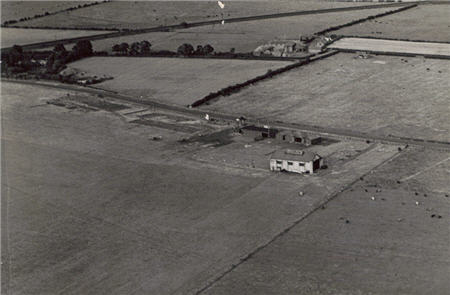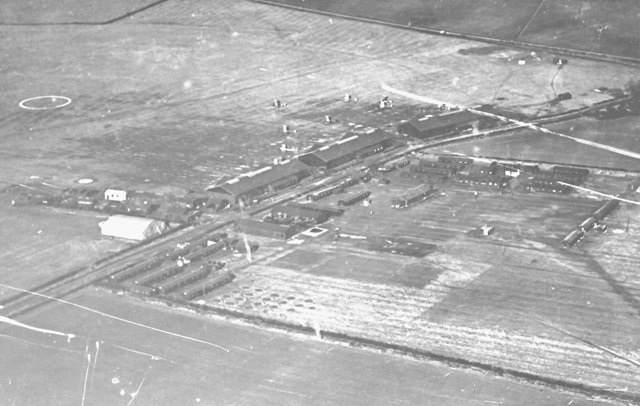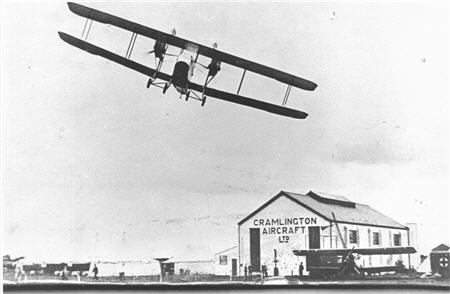Cramlington Aerodrome
(Author : Mick Davis)
Location :6 miles North of Newcastle
OS Ref : NZ 240 776
Cramlington was the first RFC station to open in the North East and
its establishment was a consequence of the German airship raids that
had began during 1915. The industrial importance of Tyneside, at
that time, was recognised by the decision to create a flight of BE2c
machines specifically for its aerial defence. The Army and Navy
were, during the closing months of 1915, involved in discussions
concerning responsibilities for Home Defence but had not reached a
formal agreement. The flight was formed nevertheless.
BE2cs 2071 and 4121 were allotted to the new unit on 24 and 25 November, respectively and the flight formed on 1 December 1915, under the command of Captain RO Abercromby. A further machine, 4130, was allocated two days later. The aerodrome was a large field to the south of the main railway and to the west of the Seaton Burn-Bedlington road. Canvas hangars were provided to accommodate the aeroplanes.
The Admiralty and War Office resolved their differences at a meeting on 26 January 1916 and agreed that the Army would be responsible for the overland defence of the UK while the Navy would tackle raiders as they approached to coastline. The Army quickly brought forward plans for the creation of Home Defence squadrons that would be deployed to protect areas of strategic importance.

An aerial view of the Cramlington aerodrome looking East, circa 1915 (NEAM Archive)
The Tyneside HD flight had been subsumed into 36 Squadron, which formed in 8th Wing, VI (Training) Brigade at Cramlington on 1 February 1916 and under the command of Abercromby. On 18 March, the unit was re-designated 36 (Home Defence) Squadron, the first such unit to be created, but still under VI Brigade and responsible for pilot training as well as its titular function.
The aerodrome was developed into a more permanent station. Three 1915 pattern flight sheds, each measuring 210 x 65 feet, were erected along the eastern boundary and extensive hutting was built on the opposite side of the road to provide office space, stores and accommodation for the personnel. The aerodrome was developed further, during the war, until it occupied 155 acres and had maximum dimensions of 800 x 600 yards. At 250 feet above sea level, it was less prone to being fogged in than stations on the coast.
36 (Home Defence) Squadron’s dual role was reflected in the aeroplanes it had on charge. In addition to BE2cs, it also received a BE2b, Avro 504s and AW FK3s. Some of the BE2cs were fitted for night flying by the addition of wing-tip brackets for Holt’s flares and the fitting of navigation lights. They were to be flown a single-seaters and armed with HE bombs (with disc nose pieces), Ranken darts, 16-lb incendiary bombs and Lewis guns that were mounted to fire over the centre-sections of the mainplanes. That variety of armament was a reflection of contemporary ignorance concerning the best method of attacking airships.
The region’s first airship raid of 1916 occurred on the night of 1/2 April, when the naval Zeppelin L11, commanded by Kvtkptn V Schütze, crossed the coast at Seaham, headed inland to drop bombs around Hetton-le-Hole, then proceeded northward to bomb Sunderland and finally turned to fly down the coast to bomb Port Clarence before returning home. The raid lasted just over 1½ hours. 36 (Home Defence) Squadron sent out two machines, but neither made contact.
L16, under Obltn zur See W Peterson, flew over Northumberland for 90 minutes the following night. Having made landfall near , L16 bombed the Ponteland area and headed back to the coast, dropping further bombs. Some of these fell on and near Cramlington aerodrome but there is no record of any sortie being made. The airship departed the coast near Coquet Island shortly after midnight
A third raid, four nights later, saw L16, with Peterson again in command, drop bombs in the Bishop Auckland area. After L16 had departed the coast, L11 came in to bomb Skinningrove. This time, a pair of BE2c went up from Cramlington but both crashed on return, with Captain J Nichol being killed when his bombs exploded as 2739 hit a building on the landing approach.
Command of the unit passed to Major CS Burnett on 24 April. Operational equipment level was well below that intended, with only 6 BE2c and 2 Bristol Scout Ds on charge. The squadron was also undermanned at the time with Burnett doubling as A Flt commander since Nichol’s death and Captains HF Glanville and ED Horsfall in charge of B and C Flts respectively. Lt JP Inglefield was the only other pilot qualified for night flying and the unit’s only other officer was 2Lt J Armee, Assistant Equipment Officer. Four officers were attached and under training.
Control of the station was passed to 19th Wing when that command was formed on 1 May. Night landing grounds had, by then, opened for 36 (Home Defence) Squadron, in order to provide for the real possibility of patrolling machines being unable to return to base through fuel shortage, engine failure or adverse weather. Those sites were at Cleadon, Currock Hill, Ponteland, Seaton Carew, Spennymoor, West Town Moor (Hylton) and Yarm (Thornaby).
The concentration of
the entire squadron on one station was not considered suitable. The
unit was intended to cover the area from the
The impracticality of
Home Defence squadrons also having a training commitment soon became
apparent and that secondary role was to be withdrawn. One
consequence of this at Cramlington was the formation of a new unit,
58 Squadron, on 8 June. The nucleus of the new squadron’s personnel
was provided by 36 (Home Defence) Squadron, as was much of its
initial equipment, in the form of Avro 504s (2912, 2914, 2935 and
7739), BE2b 2772, BE2cs that were training machines (2749, 4559 and
4590) and an AW FK3 (5514). The personnel included Horsfall, who
soon received his majority and command of 58 Squadron. A second
consequence of the withdrawal of 36 (Home Defence) Squadron’s
training commitment was a change in higher command, with its
attachment to 16th (Home Defence) Wing from that unit’s
formation on 25 June. From 29 July 16th Wing became known
simply as the Home Defence Wing. BE2b 2772 was lost in a crash on 5
July, in which 2Lt EC Berry probably became 58 Squadron’s first
fatality.
Bristol Scouts were unsuitable for night flying and they too were disposed of by 36 (Home Defence) Squadron, whose establishment was made good by the receipt of further BE2cs, as well as BE2es and BE12s, the latter a single-seat development of the BE2c that was fitted with the 140-hp RAF4 engine.
A Flight of 36 (Home Defence) Squadron was duly detached to the existing landing ground at Seaton Carew, which was then up-graded to Flight Station status. B Flight remained at Cramlington until it was moved to a new Flight Station, Hylton, by October. C Flight was scheduled to move to the new Flight Station at Ashington, but also remained temporarily at Cramlington.
That flight, by then
under the command of Captain CG Burge, had been nominated to
participate in wireless trials. The value of aircraft pilots being
able to receive telegraphed information and instructions from the
ground, during raids, had been appreciated. A
36 (Home Defence) Squadron’s HQ and staff had remained at Cramlington throughout this period but the departure of B and C Flts made the location unsuitable. A more central location was needed and so the HQ moved into requisitioned property in Jesmond on 12 October. It was policy, at this time, to avoid placing squadron HQ on a Flight Station as this may have been construed as the commanding officer favouring the resident flight above the others.
One of 36 (Home
Defence) Squadron’s last duties at Cramlington was to oversee the
formation of another new squadron. 76 (Home Defence) Squadron was
scheduled to take over the aerial defence of
58 Squadron then
remained the sole unit at Cramlington until 31 October, when 63
Squadron, under Major AC Boddam-Whetham, moved in from Raploch,
25 Squadron passed
through Cramlington during the final week of 1916, as part of its
move from Montrose to Narborough, with its machines departing for
their next stop-over point at Catterick on
A more unusual machine on 63 Squadron’s strength during early 1917 was DH2 7866, one of a handful of those pusher scouts that had been evaluated for possible Home Defence duty, found unsuitable for the task and handed on for training purposes. The squadron had provided the nucleus of 52 Reserve Squadron, which formed on 14 January and left for Catterick four days afterward.
1917 saw the
introduction of new aeroplane types at Cramlington. 58 Squadron
began to receive small numbers of Martinsyde G.102s and some of the
first of the new Armstrong Whitworth FK8s, its intended operational
equipment. 63 Squadron was then earmarked for service as a
Corps-Reconnaissance unit in the
Command of 63 Squadron
had passed to Major JC Quinnell on 27 April. The unit’s personnel
left for
58 Squadron was, once again, the station’s sole occupant until 10 October, when the nucleus of 69 Training Squadron arrived from Catterick. That unit was intended to train day light bombing pilots but there is little record of its brief time at Cramlington. It may be that the unit was still an administrative nucleus until it moved to Narborough on 9 December.
December saw the
arrival of Captain CF Collett MC* at Cramlington. That pilot had a
distinguished operational career with 70 Sqn in
Still under Horsfall’s
command, 58 Squadron received notification of its mobilisation for
active service in late 1917. All of its training had been on tractor
machines but, on 22 December, it moved to
The day of 58 Squadron’s departure from Cramlington saw the arrival of a replacement unit. 75 Training Squadron had formed, the last Training Squadron to do so, at Waddington on 14 November. It was a higher Training Squadron, intended to provide pilots for day light bomber squadrons that were then operating DH4s and were scheduled to receive DH9s. DH4s were never numerous in training units and 75 Training Squadron was initially equipped with a miscellany of types that also included Avro 504Js, RE8s, BE2es, DH6s and Martinsyde G.102s.
RFC planning for 1918
included a massive expansion of its day light bombing force and one
consequence of this was the formation, for such duty, of 120
Squadron at Cramlington on

An aerial view of the Cramlington aerodrome looking
North West, circa 1918
(Mick Davis)
Operational flying
briefly returned to Cramlington after the formation of the RAF on
Armstrong Whitworth had built a new scout, the FM4 Armadillo, and considered the Newcastle Town Moor aerodrome unsuitable for its test flying. The company sought and was granted permission to use Cramlington for that purpose and the testing began on 6 April. The machine proved unsatisfactory and did not go into production.
The Special Duties
Flights were absorbed into 252 Squadron when that unit formed, with
its HQ at
Cramlington became involved in the wholesale re-organisation of the RAF’s training programme that took place in the summer of 1918, after smaller-scale trials had proved the worth of a new system. Hitherto, pilots underwent initial training at an elementary Training Squadron before moving on to a higher Training Squadron, usually at a different station, for introduction to operational machines. This, it was realised, was expensive in time and resources and the panacea was the creation of Training Depot Stations, which would take a pilot through all stages of training. Cramlington was designated 52 TDS which was formed from 75 Training Squadron on 15 July. Its function was to train pilots for day light bombing work and it was to have a strength equivalent to two Training Squadrons, with an official establishment of 24 Avro 504Ks and 24 DH9s. Initially, 52 TDS operated machines it had inherited from 75 Training Squadron; RE8s and DH6s, as well as DH9s. New Avros began to arrive during August.
The final stages of the training programme included formation flying and instruction in the use of armament. An aerial firing range had been set up off Newbiggin using moored targets and the remote Wingates Moor, four miles west of Longhorsley was used as a bombing ground by both resident units.
The creation of 52 TDS
meant that the station was again overcrowded. 120 Squadron,
therefore, moved out, to Bracebridge Heath near
The existing hangarage
at Cramlington had never been sufficient to house the aeroplanes of
two units, or their equivalent, and a pair of Bessonneau hangars was
erected as a temporary solution to this problem. A more permanent
solution was the construction, in late 1918, of a coupled 1917
pattern GS shed, measuring 170 x
A new system of creating RAF squadrons was introduced by late 1918. Nucleus flights were created at separate stations and were then brought together for mobilisation. 52 TDS oversaw the formation of a flight of 156 Squadron that moved to its mobilisation station, Wyton, on 2 October.
52 TDS continued its everyday activities for the duration of the war and, although at a reduced pace, through to September 1919, when it was re-designated 52 Training Squadron. That re-designation was coupled with a reduction in strength to ten officers and one hundred other ranks and, by then, most flying was done on Avro 504Ks. That squadron’s existence was brief and it was disbanded on 2 October, bringing an end to service flying at Cramlington.
A Storage Detachment had been formed at the station, to collect and maintain equipment from other local aerodromes as they closed, but it soon disbanded.
The Air Ministry announced the intended closure of the station on 6th November 1919 and that process had been completed by 22nd January 1920. A Care & Maintenance party remained and one of its duties was the running of a meteorological station that had been established on the site. The final RAF presence was withdrawn that March.
The Cramlington Aircraft Ltd company was established here in the early 1920's by co-owners Connie Leathart and Leslie Runciman (former 607Sqn), operating aircraft such as the DH63A Puss Moth (G-ABLG, G-ABWG), DH63G Gypsy Moth (G-AAIB, G-ABRT) and Simmonds Spartan (G-AAGV, G-ABXO).
By the time the Newcastle Aero Club had formed here in July 1925 the airfield had fallen into a state of disrepair and a new hangar was required as a priority. The £400 required (a vast some of money in those days) was somehow found allowing the aero club to be officially opened on Saturday 21st November 1925 flying new DH60 Cirrus Moth's G-EBLX 'Novacastria' & G-EBLY 'Bernicia' which had been purchased with a £2,000 grant from the Air Ministry.
In 1928 a violent storm ripped through the aero club hangar resulting in the roof collapsing onto three hangared aircraft. Club members railed and raised the necessary funds to repair all three aircraft.
The aero club vacated Cramlington in 1935, moving to the new airfield at Woolsington and by the time World War Two started, the airfield had officially closed.

A Handley Page W.8 over the Cramlington aerodrome during the 1932 Air Pageant (NEAM Archive)
Based units
| Unit | Arrived From | Arrival Date | Dept Date | Departed To | Aircraft |
| Tyneside HD | (Formed) | 01/12/1915 | 01/02/1916 | (Subsumed into 36(HD)Sqn) | BE.2c |
| 36Sqn / 36(HD)Sqn | (Formed) | 01/02/1916 | 12/10/1916 | HQ to Newcastle A Flt to Seaton Carew B Flt to Hylton C Flt to Ashington |
Avro 504, AW FK.3, BE.2b, BE.2c, Bristol Scout |
| 58Sqn | (Formed) | 08/06/1916 | 22/12/1917 | Dover | From 36Sqn : Avro 504, AW FK.3, AW FK.8, BE.2b, BE.2c, BE.12, Martynside G.102 |
| 76Sqn | (Formed) | 15/09/1916 | 10/10/1916 | HQ to Ripon, Flts to Catterick, Helperby & Copmanthorpe | From 36Sqn : BE.2c, BE.12, DH.6 |
| 63Sqn | Stirling | 31/10/1916 | 23/06/1917 13/08/1917 |
En-route to Middle East. Basra |
Avro 504, AW FK.3, BE.2c, BE.12, DH.2, RE.8 |
| 47RS | (Formed) | 02/11/1916 | 13/11/1916 | Waddington | From 58Sqn : Various |
| 52RS | (Formed) | 14/01/1917 | 18/01/1917 | Catterick | From 63Sqn : BE.2c, DH.4 |
| 61RS | (Formed) | 01/05/1917 | 10/05/1917 | South Carlton | Various |
| 69TS | Catterick | 10/10/1917 | 09/12/1917 | Narborough | Administrative Nucleus only? |
| 75TS | Waddington | 22/12/1917 | 15/07/1918 | (Formed 52TDS) | Avro 504J, BE.2e, DH.4, DH.6, DH.9, Martynside G.102, RE.8 |
| 120Sqn | (Formed) | 01/01/1918 | 03/08/1918 | Bracebridge Heath | Avro 504J, BE.2e, DH.4, DH.6, DH.9, Martynside G.102, RE.8 |
| Special Duty Flt | (Formed) | 04/1918 | 01/05/1918 | (absorbed into 252Sqn) | ? |
| 252Sqn 507Flt 508Flt 510Flt 509Flt |
(Formed) | 01/05/1918 24/05/1918 24/05/1918 29/05/1918 07/06/1918 |
08/06/1918 08/06/1918 29/05/1918 ??/06/1918 |
HQ South Shields Tynemouth Tynemouth Redcar Seaton Carew |
DH.6 |
| 52TDS | (Formed from 75TS) | 15/07/1918 | ??/09/1919 | (Re-designated 52TS) | DH.6, DH.9, Avro 504J, Avro 504K, RE.8 |
| 52TS | (Formed from 52TDS) | ??/09/1919 | 02/10/1919 | (Disbanded) | Avro 504K |
